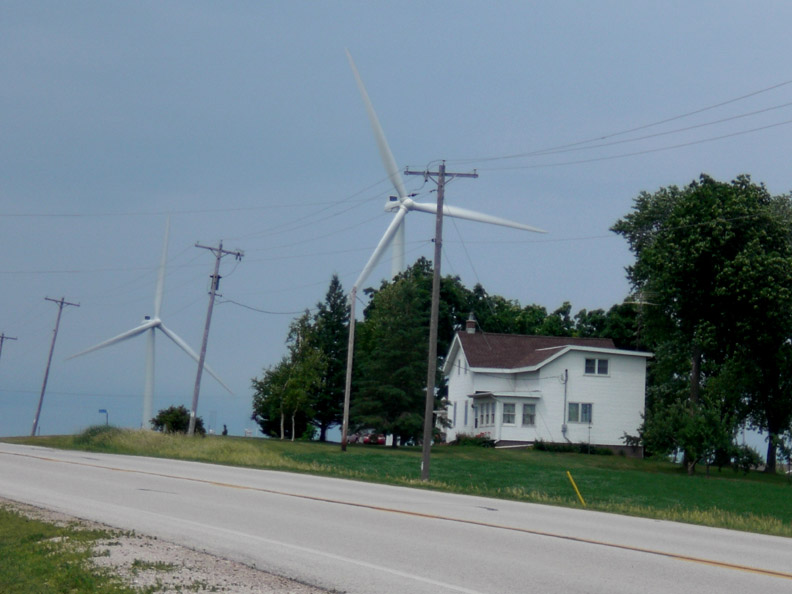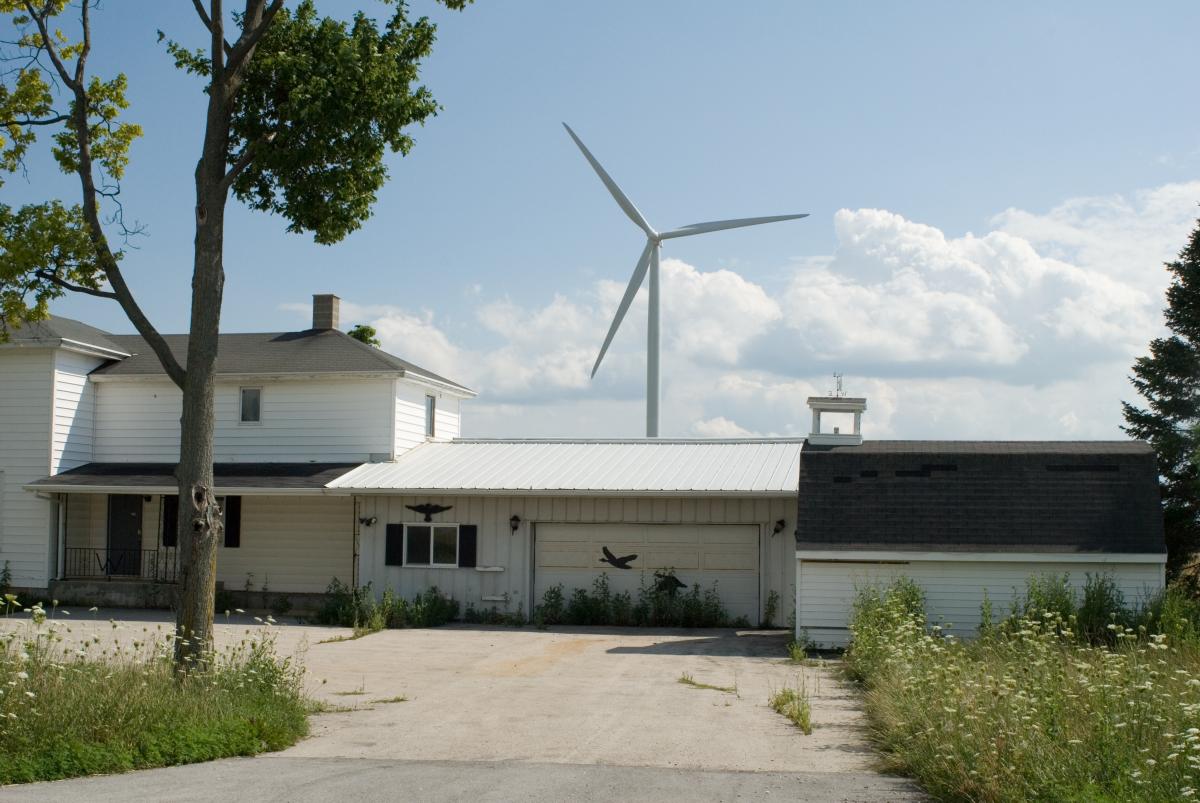 Butler Ridge Wind Farm near Iron Ridge WI Summer 2009 photo by Lynda BarryThe War Over Wind: Critics say green groups are too tight with industry.
Butler Ridge Wind Farm near Iron Ridge WI Summer 2009 photo by Lynda BarryThe War Over Wind: Critics say green groups are too tight with industry.
By Brian McCombie
The Isthumus, Madison Wisconsin
September 10, 2009
[Click here to read at source]
It was the strangest sensation Lynda Barry ever felt: a near-constant vibration within her body. "You know how sometimes, around your eye, you'll get this little tic that kind of wiggles?" says Barry, of Footville, Wis., south of Janesville. "It was like having that in your ear and your chest. A pulsing. It's the weirdest feeling!"
Barry was standing in a house in Fond du Lac County, near a wind farm. The vibration she felt was created by wind-power turbines, one just 1,100 feet away. These were part of the Blue Sky Green Fields wind project, 88 wind towers owned and operated by We Energies. The owners of the house complained of ringing in their ears anytime the wind turbines and their 100-foot blades were spinning.
In all, Barry has visited more than 20 Wisconsin households located near wind-power projects, and spent many nights at various houses.
"A couple nights, it sounded like there was a washing machine or dishwasher running in the basement," she recalls. "A few times, it was like a jet coming through the house."
Barry became involved in wind-power issues a couple years back when a wind facility was proposed near her Rock County home. An author, playwright and cartoonist for alternative newspapers (her comic appeared in Isthmus from 1983 to 1995), Barry felt too little attention was being given to people actually living near Wisconsin wind farms. So she began visiting.
Admittedly, some people don't have any problems with the spinning turbines. Many others, though, think the noise, vibrations and flickering shadows created by the spinning turbine blades cause headaches, disorientation and sleep deprivation.
"What was really bothersome was just how distressed people were," says Barry. "You just see it over and over again."
What also troubles Barry is that various Wisconsin "green" groups have, in her opinion, downplayed environmental and human health concerns in their quest for renewable wind energy. They also seem far too willing to ride roughshod over the concerns of local communities.
"I don't doubt that their hearts are in it," says Barry of these groups, especially Clean Wisconsin and RENEW, which are supporting a wind-energy bill making its way through the Wisconsin Legislature. "They're paid lobbyists rather than environmental groups, though they don't go out of their way to let people know this," she says. "I'm so hoping that real environmental groups look more deeply into wind power."
Glenn Stoddard agrees. An environmental lawyer now operating from Eau Claire, Stoddard worked with Madison attorney Ed Garvey a decade ago. While in Madison, Stoddard represented a group of people who felt a wind farm near their homes greatly diminished their quality of life. Since then, Stoddard has helped a number of local governments create wind-power ordinances.
From that work, Stoddard has come to the same conclusions as Barry about "green" groups either not recognizing or choosing to ignore wind power's toll on people and the environment. He believes Clean Wisconsin and RENEW are, at the very least, fudging reality in the claims they make in support of wind power. He also thinks they've been too influenced by membership dues derived from wind developers and the energy industry, and by private foundation grants seeking to promote renewable energy.
"The utilities don't really reduce their use of fossil fuels, because when the wind isn't blowing or the turbines aren't functioning, they have to have backup power — it's always up and running," says Stoddard. "I didn't want to come to this conclusion, but it's almost, in my opinion, just a huge environmental Ponzi scheme."
Stoddard insists he's not opposed to alternative energy or even wind power. "Unfortunately," he says, "I think some environmental groups are not able or willing to look critically at these issues and, instead, have thrown in with the developers of these types of projects and technologies, who are really just in it for the money."
Representatives of Clean Wisconsin and RENEW vehemently deny any collusion, financial or otherwise, between themselves and the wind-power industry.
"We represent ourselves," says Michael Vickerman, RENEW's executive director. "It's true we have some wind companies as members. But a pretty small fraction of our revenue base comes from the wind developers — less than 5% of our annual revenues. I haven't received a dime from any wind company to lobby."
Ryan Schryver, an energy advocate with Clean Wisconsin, takes a similar stand.
"We certainly do receive a lot of [foundation] funding to promote renewable energy," he says. "It's what environmental advocacy organizations do. As far as I know, we've never received any funding specifically to promote wind power."
Clean Wisconsin and RENEW both have employees registered with the state as paid lobbyists — five and three, respectively, as of July 2009.
Schryver and Vickerman argue that wind power, whatever its problems, represents a much better alternative to Wisconsin's energy needs than electric generation power plants burning fossil fuels. As Schryver puts it, "Right now, wind power is the most cost-competitive form of renewable energy out there and the best way to wean ourselves off fossil fuels."
Wind power is rapidly becoming a big business in Wisconsin, with millions upon millions of dollars at stake. Developers are very eager to expand wind operations here.
That yen for expansion has taken a political form with Senate Bill 185, which would set certain standards for wind developers. The bill, in its current form, removes nearly all local regulatory power over wind-power development, putting it in the hands of the Wisconsin Public Service Commission (PSC).
If SB-185 passes, the PSC will be charged with considering human health and safety, as well as environmental issues, when setting development standards. The bill will make it much harder to actually stop a proposed project, by putting the onus on local communities to prove that a new wind facility will be a problem.
A few years back, a wind developer called EcoEnergy came to the town of Union, in Rock County just northwest of Janesville, and began signing landowners to wind-tower leases. Union had no wind regulations on the books, and, faced with untold numbers of the towers going up, it placed a moratorium on new construction. It then set out to draft a wind-power ordinance, at a cost of nearly $45,000.
"We had a lot of health and safety concerns," says Kendall Schneider, Union's town chairman.
Research done by a local law firm discovered that multi-tower operations generated not only electricity but also low-frequency sounds that move through the ground. Many reports, anecdotal and scientific, suggested that wind towers gave people headaches and disturbed their sleep patterns. Birds may be killed, while other wildlife are scared away. Placing towers in the town of Union would require blasting into the bedrock, which could fracture the rock and divert pollutants into the groundwater.
Wind towers have collapsed in the past, Schneider notes, in one case killing two wind-power workers in the state of Oregon. The turbines may also throw off the thick layers of ice that can form on the blades, sometimes hundreds of feet. And then there is the question of what happens to 400-foot towers when they reach the end of their useful lives.
"We might have these things standing around in disrepair in 20 years," says Schneider, making them a safety threat and eyesore that would hurt property values.
The town of Union's "Large Turbine" ordinance requires setbacks of a half-mile from existing property lines — much farther than the 1,000-foot setback in a model ordinance for towns and municipalities on the PSC's website. And it lays out developer/owner responsibilities for removing the towers at the end of their useful lives.
The ordinance passed last November. Schneider says EcoEnergy never put in an application to build its towers, but he doesn't think it's lost interest. "Basically, they started lobbying at the Capitol and tried to get their foot in that way."
"That way" is SB-185 (its companion in the Assembly is AB-256), which has drawn opposition from local governments throughout Wisconsin.
"We've opposed the bill," says Rick Stadelman, executive director of the Wisconsin Towns Association. "We feel it takes away local control and turns it over to the PSC — which has not demonstrated a history of being impartial on this issue." He thinks that's clear from the PSC's support for the model ordinance, which he says was essentially drafted by the wind-power industry.
SB-185, says Stadelman, makes the PSC the final arbiter on any future conflicts between wind-power developers and local communities.
"PSC has a charge to come up with 25% alternative energy [use], according to the Governor's Task Force [on Global Warming], by 2025," says Stadelman. "Yet they're going to decide if a particular wind-power ordinance is reasonable or not? We think there's a basic conflict there."
Clean Wisconsin and RENEW also promote wind power as an economic boon for the state. For example, landowners receive leases of $5,000 to $8,000 per year for having wind towers on their lands. Local units of government receive money, too. Vickerman says the Blue Skies Green Field project pays out $580,000 annually, split between Fond du Lac County and the townships of Calumet and Marshfield. The project is also home to an operations center, employing 13 people full-time.
Local ordinances, like those in the town of Union, are such a stumbling block for wind development, says Vickerman, that Wisconsin utilities are loath to build here. He points to two wind projects the PSC recently green-lighted for Wisconsin utilities — in Iowa and Minnesota. The lost economic effects go far beyond the combined construction cost of $750 million.
Schryver, of Clean Wisconsin, sees wind power as a nice addition to Wisconsin's energy mix: "Especially when you look at it from a regional perspective, wind-power installations across the region are providing a lot of steady, predictable power for the grid."
Yet wind power is often misleadingly characterized as displacing the need for fossil fuels. Reading RENEW and Clean Wisconsin press releases and documents, for example, one can easily get the sense that energy-grid operators check to see how much wind power is forthcoming, and then call upon fossil-fuel-generating power plants to make up the difference. Yet, even as described by Schryver and Vickerman, that's not what happens at all.
Power companies have to provide enough electricity to meet their customers' daily needs and peak demands. That means coal and natural gas power plants are up and running at all times. Natural gas plants can run at reduced levels, as they can be jump-started rather quickly to make up for electricity shortfalls. But coal plants can't get going fast enough to contribute should wind energy fail on any given day. So power companies keep those plants churning, whether wind turbine blades are spinning or not.
Another sign that green groups may be going the extra mile in their support for wind power is Vickerman's dismissive response to the concerns about noise raised by those who live nearby.
"There's lots of things you can hear," he says. "This is the time of the year when you can hear crickets, all day and all night. Has there been an allegation stemming from that sound, that, you know, [we] can't live near crickets?"
Vickerman is equally dismissive of human health problems attributed to wind turbines.
"The opposition websites are brimming with these allegations, " he says. "But no causal relationship has been established. We don't think any health impacts have been established that are directly attributable to wind generation." He adds, "It's up to those who allege there are health impacts to document them. The burden of proof is on them."
A white paper published by the Minnesota Department of Health in May 2009 found that wind power indeed comes with human health consequences. The paper is a survey of other work and research, much of it done in Europe, which has a longer history with wind power. It concluded that the closer people live to wind towers, the more likely they are to have health problems.
The town of Union examined much of the same evidence. Its ordinance states: "Large wind turbines create a noise annoyance that can hinder physical and mental healing and can cause adverse health effects associated with sleep disturbance and deprivation, psychological distress, stress, anxiety, depression, headaches, fatigue, tinnitus and hypertension." And it refers to testimony from residents from communities with newly constructed turbines regarding "sleep deprivation and disturbance, headaches, nausea and dizziness."
Whether it comes from RENEW, Clean Wisconsin or wind developers, there's a clear assumption that wind power is good and green and very needed. So we must have more! Negative effects? Highly unlikely. And if there are problems...we'll deal with that later.
For instance, Alliant Energy sited some wind towers very close to Horicon Marsh, a major habitat for waterfowl, songbirds and raptors, plus a migratory stopover for millions of birds every year. Wind turbines do kill birds, though it's unclear how many. So when groups like Wisconsin Audubon voiced concerns, the Department of Natural Resources and Alliant agreed to a bird mortality research project — after the towers were up and spinning.
Senate Bill 185 takes the same "done deal" approach. As the bill clearly states, as long as a developer meets future guidelines, a community will have to accept said project whether it wants to or not.
"It's basically a preemption of local ordinances," says Stoddard. "The state knows best, the state knows what people need, and everything's going to be standardized."
Senate Bill 185 passed out of both the Assembly and Senate utility committees this summer, 10 to 2 in the Assembly, 6 to 1 in the Senate, and will likely see votes in both houses when the Legislature reconvenes Sept. 15-24. If the bill becomes law, Schryver expects several hundred new wind towers in the near future, with hundreds more to follow.
Lynda Barry has the same expectation — and dreads it.
"To meet the Governor's Task Force on Global Warming goals, they're going to have to site 14,000 new wind towers by 2024," says Barry. "That means all of rural Wisconsin, as far as I can tell."






